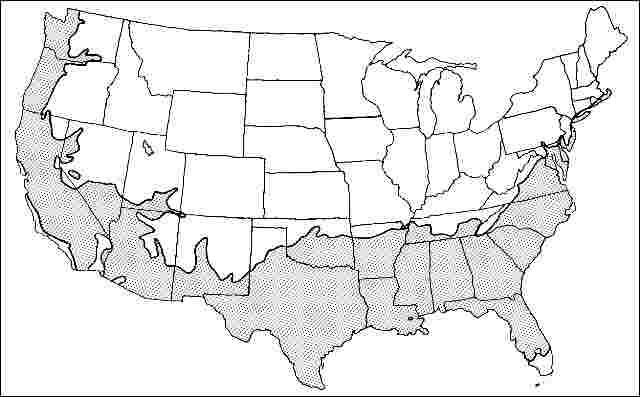Introduction
First discovered by William Bartram along the Ogeechee River in Georgia, Ogeechee-lime is a lovely native tree which reaches 40 feet in height and is pyramidal when young, maturing to a spreading, flat-topped crown. The multiple, irregular branches emerge from a trunk covered with dark brown or grey, ridged bark, and the base of the tree often develops swollen buttress-type roots as it gets older. The four- to six-inch-long, dark green leaves are joined in early spring by dense, hanging clusters of small, white blooms. The 1.5-inch-long, showy red fruits on female trees are produced in abundance and ripen in autumn. The juice can be used as a substitute for limes, hence its common name. Fruits can make a slight mess of a sidewalk, driveway or patio. In autumn the trees put on a brilliant display of colorful foliage ranging from vivid yellow to deep purple, which would make Ogeechee-lime a popular landscape choice. Unfortunately, it is usually not grown by many nurseries.

Credit: Ed Gilman, UF/IFAS
General Information
Scientific name: Nyssa ogeche
Pronunciation: NISS-uh oh-GEE-chee
Common name(s): Ogeechee tupelo, Ogeechee-lime
Family: Nyssaceae
USDA hardiness zones: 7A through 9B (Fig. 2)
Origin: native to North America
Invasive potential: little invasive potential
Uses: reclamation; street without sidewalk; shade; parking lot island 100-200 sq ft; parking lot island > 200 sq ft; highway median; specimen; tree lawn 4-6 feet wide; tree lawn > 6 ft wide; sidewalk cutout (tree pit)
Availability: native to North America

Description
Height: 35 to 45 feet
Spread: 25 to 35 feet
Crown uniformity: symmetrical
Crown shape: round
Crown density: moderate
Growth rate: moderate
Texture: medium
Foliage
Leaf arrangement: alternate (Fig. 3)
Leaf type: simple
Leaf margin: entire, sinuate/undulate, undulate
Leaf shape: elliptic (oval), obovate
Leaf venation: pinnate
Leaf type and persistence: deciduous
Leaf blade length: 4 to 8 inches
Leaf color: green
Fall color: yellow, purple, orange, red
Fall characteristic: showy

Flower
Flower color: white/cream/gray, yellow
Flower characteristics: not showy
Fruit
Fruit shape: round
Fruit length: .5 to 1 inch
Fruit covering: fleshy
Fruit color: red
Fruit characteristics: attracts birds; showy; fruit/leaves a litter problem
Trunk and Branches
Trunk/bark/branches: branches droop; showy; typically one trunk; thorns
Pruning requirement: little required
Breakage: resistant
Current year twig color: green
Current year twig thickness: medium
Wood specific gravity: 0.46
Culture
Light requirement: full sun, partial sun, or partial shade
Soil tolerances: clay; sand; loam; acidic; extended flooding; well-drained
Drought tolerance: high
Aerosol salt tolerance: unknown
Other
Roots: not a problem
Winter interest: no
Outstanding tree: no
Ozone sensitivity: unknown
Verticillium wilt susceptibility: unknown
Pest resistance: resistant to pests/diseases
Use and Management
Since the sex on trees can be determined at an early age in the nursery, it should be easy to select male trees. Those may be preferrable since the fruits on female trees can be somewhat messy on pavement and walks.
Since it is most often found along streams and in low-lying areas which are regularly flooded in spring and winter, Ogeechee-lime will prefer a moist site on acid soil. It is well-adapted to sites which are wet for prolonged periods, once the tree becomes established. Located in full sun or partial shade, Ogeechee-lime will easily adapt to somewhat drier locations but should be protected from harsh winds. A male selection would be useful for urban areas since it would not produce fruit.
Nyssa aquatica is very similar and difficult to differentiate from Nyssa ogeche.
Propagation is by seed.
Pests and Diseases
No pests or diseases are of major concern but it is occasionally bothered by tupelo leaf miner, scale, rust, and leaf spot.